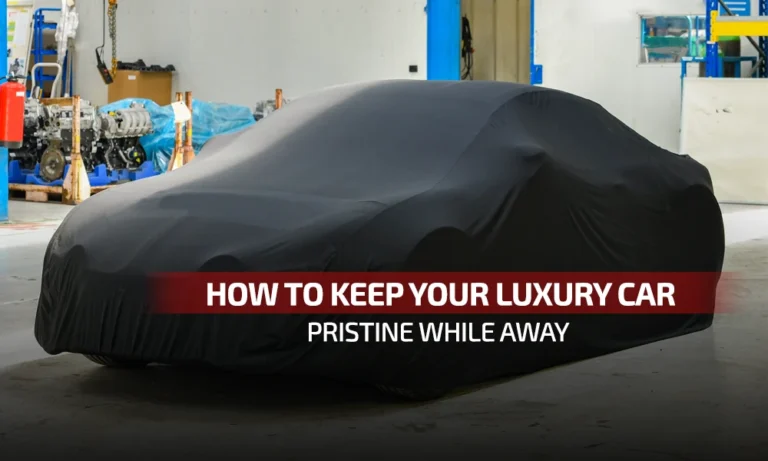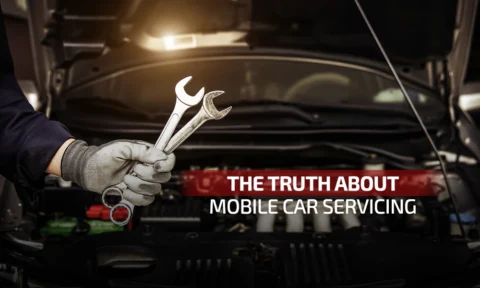Let’s get something straight: Luxury cars hate being idle.
That handcrafted V8, the multi-layer leather seats, the Pirellis hugging your forged rims—none of it was designed to sit still for six months in a UAE basement or a European villa’s garage.
And yet, most owners do exactly that.
They fly off for summer in Europe, leave their Ferrari SF90 or Porsche Taycan parked, and come back to a drained battery, flat-spotted tires, and a stale cabin that smells like the glovebox of a 2005 Corolla.
That’s not carelessness. That’s just a lack of proper long-term storage prep—and that’s what we’re fixing today.
Step 1: Battery Maintenance Is Non-Negotiable
Modern luxury cars are software-heavy, power-draining machines, even when turned off.
Your car’s battery is still powering the security system, GPS, smart locks, and dozens of ECUs in sleep mode.
Can a car battery die even if the car hasn’t been used?
Absolutely. In vehicles like a Mercedes S-Class or Audi A8, the battery can drain in 2–3 weeks. Always connect a smart trickle charger, ideally one recommended by your manufacturer.
Avoid disconnecting the battery unless you want to deal with error codes, electronic resets, or steering lock issues on restart.
Step 2: Skip the Parking Brake—and Flat Spots
You’d think engaging the parking brake is a smart move, right?
Not for luxury rides.
Over time, it can seize onto the rotor, especially in humid climates like the UAE.
Instead:
- Park on a flat surface
- Use wheel chocks behind the tires
- Inflate tires to the upper limit of the manufacturer’s range
- If you’re away for more than a month, consider tire cradles to prevent flat-spotting
When you do these things, you are maintaining the car even while you are not present physically.
Can luxury car tires get ruined just by sitting?
Yes. Performance tires like Michelin Pilot Sports develop memory spots when idle too long.
You’ll feel a vibration at speed once you’re back, even if the tread looks fine.
Step 3: Detail Before Storage, Not After
It might sound strange to wash and wax your car before hiding it away, but this step is crucial.
Bird droppings, road salt, and even hard water stains can etch into the clear coat, especially on softer luxury paint finishes like those on Bentley or Rolls-Royce.
- Get a full exterior detail (wax or ceramic coating optional)
- Vacuum and clean the interior
- Use moisture-absorbing gel packs inside (like silica canisters) to prevent mold in the cabin
Step 4: The Case for a Quality Indoor Car Cover
Don’t cheap out here. That $30 cover from Amazon isn’t designed for your McLaren or AMG GT.
Buy a breathable, lint-free, scratch-proof cover specifically tailored for your car’s dimensions. Something that hugs the body snugly but won’t trap moisture underneath.
Should I use a car cover if I’m storing it indoors?
Yes—especially for luxury cars. Even indoor environments collect dust, paint overspray, and debris, which can settle into fine swirls over time. A proper cover keeps your paint pristine.
Step 5: Where You Park Matters More Than You Think
Leaving your Range Rover under your villa’s carport?
Big mistake. Sunlight, temperature swings, and wind-blown dust are your worst enemies.
Even a semi-open parking spot in Dubai can wreak havoc.
If you’re serious:
- Rent a spot in a climate-controlled storage facility
- Or install a car capsule (an inflatable sealed garage) at home
- Cover any exposed metal surfaces (exhaust tips, brake discs) with corrosion inhibitors
And don’t forget—rodents are real, even in the UAE. Use peppermint oil or ultrasonic deterrents to keep them away from wiring harnesses.
Optional—but Worth It
If you’re leaving for more than 2 months, think about:
- Oil change before storage – Old oil contains contaminants that eat away at internal components.
- Fuel stabilizer – Especially for high-octane fuels. Keeps the mixture from gumming up the injectors.
- Insurance update – Notify your insurer that the vehicle will be in long-term storage. Some even offer premium reductions.
Leave It Right—Drive It Like New
Too many owners treat long-term storage like a long-term nap.
But luxury cars are more like racehorses than sleeping dogs—leave them idle too long without prep, and you’ll pay for it.
When you’ve spent six figures on a car, the least you can do is store it right. That way, when you return from your London trip or summer in the Alps, you’ll come back to a car that drives exactly like the day you left it—no surprises, no strange sounds, no flat tires, and definitely no error codes.







